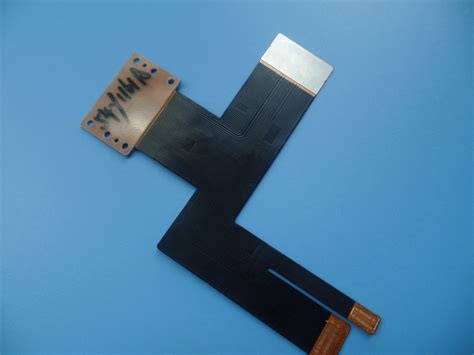Introduction to Flexible PCB
Flexible printed circuit boards, also known as flex circuits or flexible PCBs, have revolutionized the electronics industry by providing a versatile and compact solution for interconnecting electronic components. Unlike traditional rigid PCBs, flexible PCBs are made from thin, flexible materials that can bend, fold, and twist without damaging the electrical connections. This unique property makes them ideal for applications where space is limited, or where the device needs to conform to a specific shape.
What is a Flexible PCB?
A flexible PCB is a type of printed circuit board that consists of a thin, flexible substrate with conductive traces and components mounted on it. The substrate is typically made from a flexible polymer material, such as polyimide or polyester, and the conductive traces are usually made from copper. The components are attached to the substrate using various methods, such as surface mount technology (SMT) or through-hole mounting.
Advantages of Flexible PCBs
Flexible PCBs offer several advantages over traditional rigid PCBs, including:
-
Compact size: Flexible PCBs can be bent, folded, and twisted to fit into tight spaces, making them ideal for compact devices such as smartphones, wearables, and medical implants.
-
Lightweight: The thin, flexible materials used in flexible PCBs make them much lighter than rigid PCBs, which is essential for portable devices and aerospace applications.
-
High reliability: Flexible PCBs are less prone to mechanical stress and vibration, which can cause failures in rigid PCBs. They also have better thermal management properties, which can improve the overall reliability of the device.
-
Design flexibility: Flexible PCBs allow designers to create complex, three-dimensional shapes that would be impossible with rigid PCBs. This enables more creative and efficient product designs.
-
Cost-effective: In some cases, flexible PCBs can be more cost-effective than rigid PCBs, especially for high-volume production runs. They also require fewer connectors and cables, which can further reduce costs.
Types of Flexible PCBs
There are several types of flexible PCBs, each with its own unique properties and applications.
Single-sided Flexible PCBs
Single-sided flexible PCBs have conductive traces on only one side of the substrate. They are the simplest and most cost-effective type of flexible PCB, and are often used in applications where cost is a primary concern.
Double-sided Flexible PCBs
Double-sided flexible PCBs have conductive traces on both sides of the substrate, which allows for more complex circuit designs and higher component density. They are commonly used in applications where space is limited, such as smartphones and wearables.
Multilayer Flexible PCBs
Multilayer flexible PCBs consist of multiple layers of flexible substrate with conductive traces on each layer. They offer the highest level of design flexibility and component density, but are also the most complex and expensive type of flexible PCB. Multilayer flexible PCBs are often used in high-end applications, such as aerospace and medical devices.
Rigid-Flex PCBs
Rigid-flex PCBs are a hybrid of flexible and rigid PCBs, with rigid sections connected by flexible sections. This allows for even greater design flexibility, as the rigid sections can house components that require a stable base, while the flexible sections can bend and fold as needed. Rigid-flex PCBs are commonly used in applications where both flexibility and stability are required, such as automotive electronics and industrial control systems.
Manufacturing Process of Flexible PCBs
The manufacturing process for flexible PCBs is similar to that of rigid PCBs, but with a few key differences.
Material Selection
The first step in manufacturing a flexible PCB is selecting the appropriate materials. The substrate material must be flexible, durable, and able to withstand the intended operating conditions. Common substrate materials include polyimide, polyester, and DuPont’s Pyralux. The conductive traces are typically made from copper, and the thickness of the copper layer can vary depending on the specific application.
Circuit Design
Once the materials have been selected, the next step is to design the circuit. This involves creating a schematic diagram of the circuit, followed by a layout that shows the physical arrangement of the components and traces on the substrate. The layout must take into account the flexibility of the substrate, as well as any mechanical constraints or environmental factors that may affect the performance of the circuit.
Substrate Preparation
Before the circuit can be printed onto the substrate, the substrate must be prepared. This typically involves cleaning the surface to remove any contaminants, followed by the application of an adhesive layer to help the copper traces adhere to the substrate.
Circuit Printing
The actual printing of the circuit onto the substrate can be done using several methods, including screen printing, photolithography, and direct printing. Screen printing involves using a stencil to apply the conductive ink to the substrate, while photolithography uses light to transfer the circuit pattern onto a photosensitive layer on the substrate. Direct printing, also known as inkjet printing, uses a specialized printer to deposit the conductive ink directly onto the substrate.
Etching and Plating
After the circuit has been printed onto the substrate, the next step is to remove any unwanted copper to create the final circuit pattern. This is typically done using a chemical etching process, which selectively removes the copper that is not part of the circuit. In some cases, additional copper may be added to the circuit using an electroplating process to increase the thickness of the traces.
Lamination and Coverlay
Once the circuit has been etched and plated, the next step is to laminate the layers of the flexible PCB together. This involves applying heat and pressure to bond the layers together, creating a single, flexible unit. A coverlay layer may also be added to protect the circuit from damage and provide insulation between the layers.
Cutting and Finishing
The final step in the manufacturing process is to cut the flexible PCB to its final shape and size. This can be done using a variety of methods, including die cutting, laser cutting, and routing. Any final finishes, such as soldermask or silkscreen, are also applied at this stage.

Applications of Flexible PCBs
Flexible PCBs have a wide range of applications across various industries, from consumer electronics to aerospace and beyond.
Consumer Electronics
One of the most common applications for flexible PCBs is in consumer electronics, such as smartphones, tablets, and wearables. The compact size and flexibility of flexible PCBs allow designers to create smaller, more lightweight devices with unique form factors.
| Device | Flexible PCB Application |
|---|---|
| Smartphones | Connecting displays, cameras, and other components |
| Smartwatches | Conforming to the shape of the watch body |
| Earbuds | Fitting inside the small, curved housing |
Medical Devices
Flexible PCBs are also widely used in medical devices, where their flexibility and biocompatibility make them ideal for implantable and wearable devices.
| Device | Flexible PCB Application |
|---|---|
| Pacemakers | Connecting sensors and electrodes inside the device |
| Hearing Aids | Fitting inside the small, curved housing |
| Insulin Pumps | Connecting sensors and displays in a compact package |
Automotive Electronics
In the automotive industry, flexible PCBs are used in a variety of applications, from dashboard displays to engine control modules.
| Application | Flexible PCB Benefit |
|---|---|
| Dashboard Displays | Conforming to the curved shape of the dashboard |
| Sensor Arrays | Connecting multiple sensors in a compact package |
| Wiring Harnesses | Reducing weight and complexity compared to cables |
Aerospace and Defense
Flexible PCBs are also used extensively in aerospace and defense applications, where their lightweight and high reliability are essential.
| Application | Flexible PCB Benefit |
|---|---|
| Satellite Systems | Reducing weight while maintaining high reliability |
| Aircraft Avionics | Fitting inside tight spaces and conforming to contours |
| Military Radios | Withstanding harsh environmental conditions |
Future of Flexible PCBs
As technology continues to advance, the demand for smaller, more complex devices will only continue to grow. This means that flexible PCBs will likely play an even larger role in the electronics industry in the years to come.
Advancements in Materials
One area where we can expect to see significant advancements is in the materials used to manufacture flexible PCBs. Researchers are continually developing new, more advanced materials that offer better flexibility, durability, and electrical performance. For example, some newer materials can stretch and conform to even more complex shapes, opening up new possibilities for product design.
Increased Adoption in Emerging Technologies
Flexible PCBs are also likely to see increased adoption in emerging technologies, such as the Internet of Things (IoT), wearables, and robotics. As these technologies continue to evolve, the demand for smaller, more flexible electronics will only continue to grow.
Integration with Other Manufacturing Techniques
Another area where we may see advancements is in the integration of flexible PCBs with other manufacturing techniques, such as 3D printing and printed electronics. By combining these technologies, designers may be able to create even more complex and customized devices that would not be possible with traditional manufacturing methods.
Frequently Asked Questions (FAQ)
-
Q: How long do flexible PCBs last compared to rigid PCBs?
A: The lifespan of a flexible PCB depends on various factors, such as the materials used, the operating conditions, and the level of flexing. In general, a well-designed flexible PCB can last just as long as a rigid PCB in the same application. -
Q: Can flexible PCBs be repaired if damaged?
A: In most cases, flexible PCBs can be repaired using specialized techniques, such as microsoldering or conductive adhesives. However, the repairability depends on the extent and location of the damage, as well as the specific materials and construction of the PCB. -
Q: Are flexible PCBs more expensive than rigid PCBs?
A: The cost of flexible PCBs compared to rigid PCBs depends on several factors, such as the complexity of the design, the materials used, and the volume of production. In some cases, flexible PCBs may be more expensive due to the specialized materials and manufacturing processes required. However, they can also offer cost savings by reducing the need for connectors and cables, and by enabling more compact and efficient product designs. -
Q: Can flexible PCBs be used in high-temperature applications?
A: Yes, some flexible PCBs are designed to withstand high temperatures, using specialized materials such as polyimide or PEEK. These materials can maintain their flexibility and electrical properties even at temperatures up to 400°C. -
Q: How do you choose the right type of flexible PCB for a given application?
A: Choosing the right type of flexible PCB depends on several factors, such as the intended use case, the required flexibility and durability, the complexity of the circuit, and the budget. Single-sided and double-sided flexible PCBs are often sufficient for simpler applications, while multilayer and rigid-flex PCBs may be necessary for more complex designs. It’s important to work with an experienced flexible PCB manufacturer who can help guide you through the selection process based on your specific needs.
Conclusion
Flexible PCBs have revolutionized the electronics industry by enabling smaller, more compact, and more reliable devices across a wide range of applications. From consumer electronics to medical devices and beyond, flexible PCBs offer a versatile and cost-effective solution for interconnecting electronic components in tight spaces and challenging environments.
As technology continues to advance, the demand for flexible PCBs will only continue to grow. With ongoing advancements in materials, manufacturing processes, and integration with other technologies, flexible PCBs are poised to play an even larger role in shaping the future of electronics.
Whether you’re designing a new product or looking to optimize an existing one, flexible PCBs are a powerful tool to have in your arsenal. By understanding the different types of flexible PCBs, their manufacturing processes, and their key applications, you can make informed decisions about how to incorporate them into your designs and stay ahead of the curve in an ever-evolving industry.
